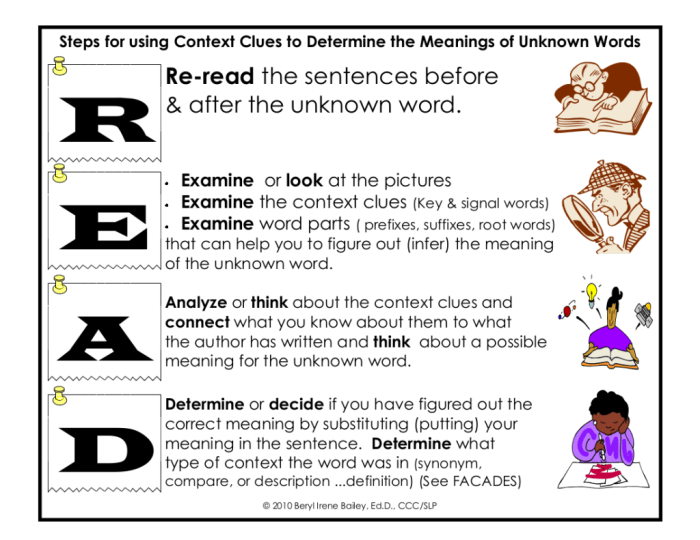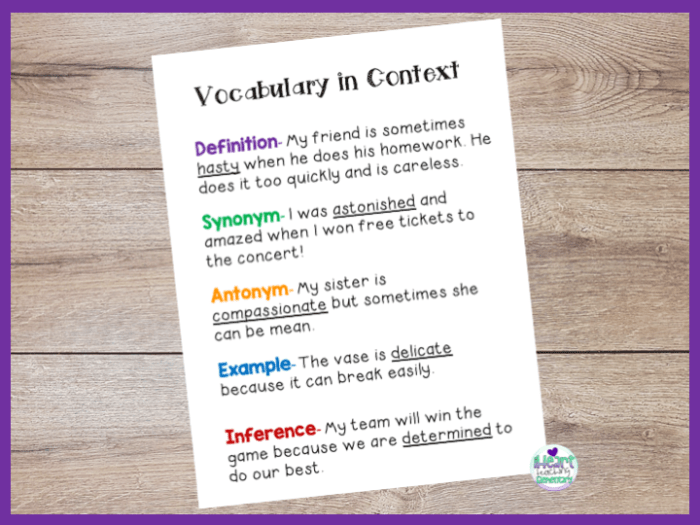Improving vocabulary with word parts and context clues is an essential aspect of language learning. By understanding the structure of words and utilizing the clues provided within text, individuals can effectively expand their vocabulary and enhance their comprehension.
This comprehensive guide delves into the concepts of morphemes, context clues, and their application in vocabulary acquisition. It provides practical strategies and exercises to help learners master these techniques and unlock the power of language.
Understanding Word Parts

Word parts are the building blocks of words. They can be broken down into three main categories: prefixes, suffixes, and roots.
Prefixes
- Prefixes are added to the beginning of words to change their meaning.
- Common prefixes include:
- un- (not): unhappy, unusual
- re- (again): restart, rebuild
- dis- (not): dislike, disagree
Suffixes
- Suffixes are added to the end of words to change their part of speech or meaning.
- Common suffixes include:
- -ment (noun): government, management
- -ful (adjective): helpful, beautiful
- -ly (adverb): quickly, slowly
Roots
- Roots are the core meaning of a word.
- Many words share the same root, which can help you expand your vocabulary.
- For example, the root “dict” means “to speak.” Words like “dictate,” “diction,” and “dictionary” all share this root.
Using Context Clues
Context clues are hints within a text that can help you determine the meaning of unfamiliar words.
Types of Context Clues
- Syntactic clues: These clues are based on the grammar of the sentence.
- Semantic clues: These clues are based on the meaning of the surrounding words.
- Pragmatic clues: These clues are based on the context of the situation.
Examples of Context Clues, Improving vocabulary with word parts and context clues
- Syntactic clue: The word “enormous” is an adjective, so it must describe a noun.
- Semantic clue: The sentence says that the dog was “huge.” The word “huge” is a synonym for “enormous.”
- Pragmatic clue: The dog is described as being “the size of a horse.” This clue suggests that the dog is very large, so the word “enormous” must mean “very large.”
Strategies for Identifying and Utilizing Context Clues
- Read the sentence carefully.
- Identify the unfamiliar word.
- Look for clues in the surrounding text.
- Use the clues to determine the meaning of the unfamiliar word.
Building a Vocabulary with Word Parts and Context Clues

Word parts and context clues can be used together to build a strong vocabulary.
Table of Word Parts
| Prefix | Meaning | Example |
|---|---|---|
| un- | not | unhappy |
| re- | again | restart |
| dis- | not | dislike |
| Suffix | Meaning | Example |
| -ment | noun | government |
| -ful | adjective | helpful |
| -ly | adverb | quickly |
| Root | Meaning | Example |
| dict | to speak | dictate |
Exercises Using Context Clues
- The dog was so ________ that he could barely fit through the door.
- The teacher’s ________ was very difficult to understand.
- The ________ of the play was very moving.
Demonstrating the Use of Word Parts and Context Clues
The word “unhappy” is made up of the prefix “un-” and the root “happy.” The prefix “un-” means “not,” so the word “unhappy” means “not happy.”
The sentence “The dog was so enormous that he could barely fit through the door” provides a context clue for the word “enormous.” The word “enormous” is an adjective, so it must describe a noun. The noun in the sentence is “dog.”
The sentence also says that the dog was “so” enormous, which suggests that the dog was very large. Therefore, the word “enormous” must mean “very large.”
Incorporating Word Parts and Context Clues into Language Learning: Improving Vocabulary With Word Parts And Context Clues

Word parts and context clues can be integrated into language learning in a number of ways.
Benefits of Integrating Word Parts and Context Clues
- Improved vocabulary acquisition
- Increased reading comprehension
- Enhanced writing skills
Techniques for Teaching Students to Use These Strategies
- Explicit instruction
- Guided practice
- Independent practice
Assessing Students’ Understanding and Progress
- Vocabulary quizzes
- Reading comprehension tests
- Writing samples
FAQ Summary
What are the benefits of using word parts and context clues?
Word parts and context clues provide a systematic approach to vocabulary expansion, enabling learners to decode unfamiliar words and enhance their comprehension of texts.
How can I effectively use context clues to improve my vocabulary?
To effectively use context clues, identify the type of clue (syntactic, semantic, or pragmatic) and utilize the surrounding words and phrases to infer the meaning of unfamiliar words.
How do I incorporate word parts and context clues into my language learning routine?
Incorporate word parts and context clues into your language learning by creating a table of prefixes, suffixes, and root words with their meanings. Practice using context clues through exercises and activities.